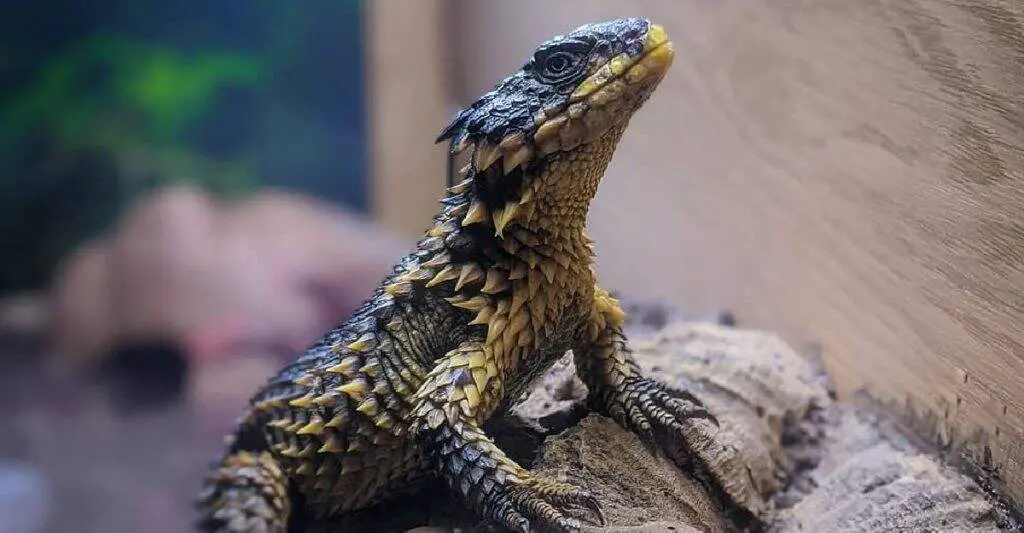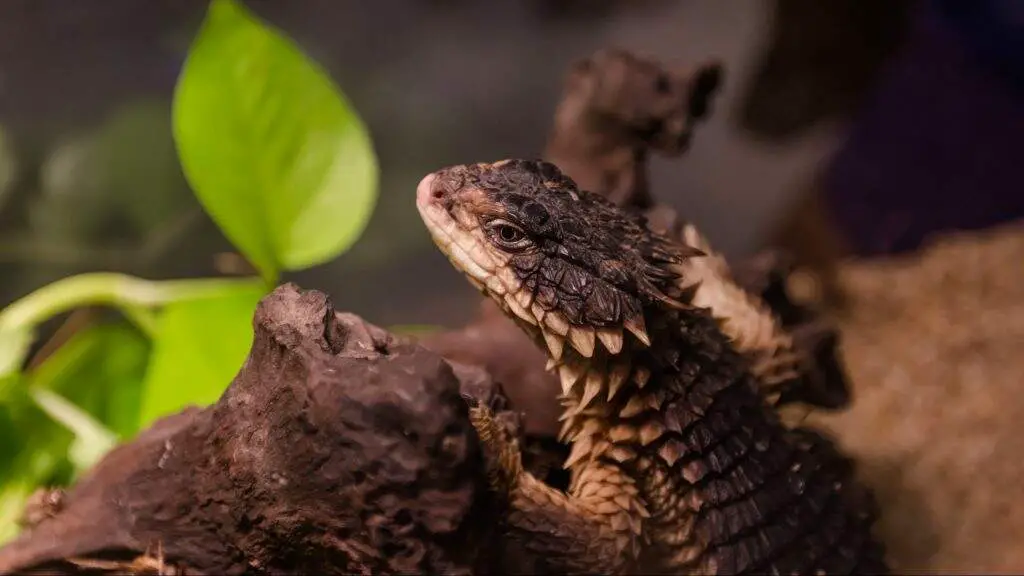Considering an Armadillo Lizard as a pet? Before you buy, learn here if they will be a good fit for your household.
In this guide, you’ll learn:
- Do Armadillo Lizards make good pets?
- What kind of care do they require?
- What are their personalities like?
- How long do they live?

Yes, Armadillo Lizards can make good pets. They are easy to look after, require basic reptile care, and are not messy. They can live up to 25 years making them excellent long-term companions! However, they are not the best reptile for kids because they do not like to be handled and are prone to bite.
The Armadillo Lizard looks like a miniature dragon straight out of a fairy tale with their triangular head, piercing eyes, and sharp scales along its armor. These fascinating lizards have the ability to roll into a ball just like armadillos, which are mammals that curl up in a defensive position to protect their underbelly.
The Armadillo Lizard (Ouroborus cataphractus) originated from the Northern and Western Cape of South Africa. They are relatively small lizards (4-6 inches) with dragon-like scales and spikes on their body. They are also known as Golden Armadillo Lizard, Armadillo Jones Lizard, Armadillo Girdled Lizard, or the Armadillo Spiny-Tailed Lizard.
Armadillo lizards require basic reptile care but have a few specific needs and characteristics that you should be aware of if you plan on getting one as a pet. This article points out some pros and cons on Armadillo Lizards as pets, basic care, and quick facts about these majestic looking creatures.
Why Do Armadillo Lizards Make Good Pets?
1. Easy to look after
Armadillo Lizards are not as messy, especially with a bioactive vivarium or tank setup with a self-contained ecosystem that includes invertebrates that eat waste. They can be fed less frequently than most lizards and can be fed crickets and other insects which are easily obtained in bulk at your exotic pet store.
2. They don’t need a large enclosure
Armadillo Lizards do not need large habitats. At just 4-6 inches in length, a couple of Armadillo Lizards will do well in 20-30 gallon tanks (2-4 sq. feet). If you plan on getting more than two lizards, a bigger tank is recommended.
3. They are sociable creatures
An interesting trait of Armadillo Lizards is that unlike most reptiles, they are social creatures. In the wild, they can be found in social groups of up to 60 lizards living together, probably to ward off prey. As pets, you can keep up to three in a relatively small tank provided that you only have one male per tank as males can get aggressive toward each other. It is even recommended that you keep at least two Armadillo Lizards together because of their social nature.
They also tend to be more curious of their surroundings and display more interest with their environment. Armadillo Lizards are observed to pop up their small heads when their owners walk past their tanks and tend to watch when something intriguing is happening around them.

Why Don’t Armadillo Lizards Make Good Pets?
Many beautiful and interesting looking reptiles and exotic animals are victims of the irresponsible pet trade. Unfortunately, Armadillo Lizards were once in danger of extinction in South Africa and until 1996 were classified as vulnerable by the IUCN (International Union for Conservation of Nature). At present, their status is of “least concern” but they remain vulnerable to predators, illegal pet trade, and climate change.
Reptiles should always be obtained from responsible breeders. Armadillo Lizards that are bred in captivity tend to be harder to find (they only give birth to 1-2 young per year) but this is the more responsible option and will ensure the sustainability of their population in the wild.
Even if you manage to find one, Armadillo Lizards are not without their quirks that may disqualify them as great pets.
1. They are prone to running away
Though Armadillo Lizards can become used to being handled, they are prone to running away at the first opportunity they get. You should avoid putting them on the ground as there is always a risk of them running away and hiding. And because they are small, it can be quite challenging to find them again.
2. They aren’t great for handling
On a related note, Armadillo Lizards aren’t that great at being handled. They don’t like to be held as much unlike more affectionate lizard companions such as bearded dragons or geckos. Armadillo Lizards aren’t the best “cuddle” buddies because of this trait. If you prefer to be able to take out your lizard and hold them regularly, then the Armadillo Lizard may not be for you.
Though often described as docile creatures, you will need to tame them and get them used to being handled while they are young. Getting Armadillo Lizards used to being held requires a lot of patience and should be done slowly as they can curl into a ball or even bite as a reflex reaction when stressed.
3. They bite
Armadillo Lizards are more prone to biting than other lizards as a defense mechanism. Their jaws are quite powerful and can even break while feeding. They have sharp teeth that will hurt and draw blood if you’re bitten. Their extremely strong bite is often responsible for the severed toes and limbs of their opponents in the wild.
What Kind Of Care Do They Require?
Though Armadillo Lizards may look like dragons, they will not need exhaustive maintenance and care as one would imagine an actual dragon needs. They only require general reptile care such as a spacious tank with places to hide and climb, a good light source (with UVB), the correct temperature gradient, and adequate food and water. When properly taken care of, Armadillo Lizards can live between 20-25 years making them great long-term pets.
Proper habitat for an Armadillo Lizard
The Armadillo Lizard’s natural habitat is the rocky deserts and mountains of South Africa (Northern and Western Cape Provinces). They live in dry, rocky areas, scrublands, rocky outcrops, and rock crevices with dense vegetation of small trees and shrubs providing numerous hiding places to escape predators and to hibernate.
Their tank or enclosure should be between 20-30 gallons for single lizards and bigger if you have more than two Armadillo Lizards together. Reptiles generally love room to roam so bigger tanks are usually better. Providing a lid is best but if your tank is tall enough, these reptiles do not climb glass too well.
Tank furniture such as branches and rocks will allow for ample climbing and hiding spaces. The substrate can be bark or reptile liners and should be changed once a month. Though Armadillo Lizards are used to sand in the wild, they can accidentally ingest this kind of substrate in their tanks. A small water dish with dechlorinated water to dip in should also be provided to help with hydration and temperature regulation.
Food and water should be cleared and replaced daily with weekly tank cleaning and monthly disinfection.
If you plan to keep more than one Armadillo Lizard tank setup, it’s good to have similar tank setups so that moving these animals from tank to tank is less stressful for them should there be aggression problems with the individuals you keep in the same tank.
Armadillo Lizard temperature requirements
Armadillo Lizard tanks should have a good temperature gradient with a basking area such as a log or rock under a heat lamp at 115-130 degrees Fahrenheit. During the day, the tank should have an average temperature between 80-85 degrees Fahrenheit and lowered to about 60-70 degrees Fahrenheit at night. Heating pads placed under the tank can help achieve this temperature gradient. Hiding places in both hot and cool areas of the tank will keep Armadillo Lizards happy.
A full spectrum bulb with UVB should be provided as a source of vitamin D3 and kept on for 12 hours to mimic their natural circadian rhythm. The humidity in the tank should be between 45-55% with daily misting.
Armadillo Lizard diet
The diet of Armadillo Lizards are mostly composed of live bugs and small invertebrates such as crickets dusted with calcium powder (for good bone development), roaches, and superworms. Butterworms and wax worms have higher fat content and should be fed sparingly. Mealworms, though common food for reptiles, should be avoided for Armadillo Lizards. Some may eat fruit and certain vegetables like carrots, squash, collard greens and most plant material. An option is to gut load crickets with calcium rich vegetables like kale, collard, and mustard greens which will help in your lizard’s nutrition. Babies and juveniles can eat once a day while adults can be fed thrice a week, even once a week. Clean water should be available for Armadillo Lizards at all times.
Armadillo Lizard lifespan & health
Armadillo Lizards are known to live up to 25 years. They are considered very hardy but can occasionally suffer from common health problems affecting pet lizards like metabolic bone disease or respiratory issues. Armadillo Lizards have minimal health problems but three possible illnesses should be noted: parasites, mouth infections, and femoral pore infections.
An Armadillo Lizard with mouth infections will run after its prey during feeding but will not bite it. Pus can also be observed in the mouth. Injectable antibiotics are the preferred treatment for these.
Femoral pores on the hind legs of Armadillo Lizards secrete a waxy substance that can clog up causing swelling. Rougher substrate and climbing rocks can help scrape some of these off and prevent infection.
Though illegal, wild caught Armadillo Lizards often have parasites that can affect its appetite. Armadillo Lizards that show no interest in food at all could be infected. These can be confirmed via a stool sample but parasites usually clear up in a few weeks.
Armadillo Lizard Overview
The Armadillo Lizard’s scientific name, Ouroborus cataphractus, is derived from the ancient symbol of a serpent or dragon eating its own tail called “ouroboros” representing infinity because of its defensive behavior of rolling into a ball and biting its tail. Aside from having this unique physical trait, Armadillo Lizards are one of the very few reptile species that give birth to live young (instead of laying eggs).
In the rocky deserts and mountain slopes of South Africa, they feed on insects, mainly termites, but can also eat spiders, millipedes, and beetles. Birds of prey are their most effective predators. Termites are often affected by changes in environment caused by climate change so Armadillo Lizards suffer the consequences in effect.
Physical characteristics of the Armadillo Lizard
Armadillo Lizards have beautiful yellowish-brown color gradients on their layered armoring consisting of square-shaped scales or spines on the dorsal side. These scales are usually arranged in girdles. Black marks and dark spots cover their chins and throats and they have a dark brown upper lip. Their ventral (bottom side) are usually a lighter yellow color.
Armadillo Lizards have a triangular head with a stocky but flattened body suited for crawling into cracks and crevices. Male Armadillo Lizards have broader and more triangular heads than females.

Armadillo Lizard behavior
The most distinguishing behavior of Armadillo Lizards is being able to roll into a ball by biting its tail as a defense mechanism. They are also known to bite. They do not take to being handled very well so they should be tamed or acclimatized when young.
Armadillo Lizards live in social groups in the wild, typically made up of an adult pair and juveniles. Males are highly territorial and are especially aggressive during mating season (during spring). Females can also display territorial behavior in a group, especially without an alpha male. These lizards communicate typically by head bobbing, tail wagging, and tongue flicking, often to express their annoyance at a cagemate or an unfamiliar Armadillo Lizard.
Armadillo Lizards give birth instead of laying eggs. They carry their young for about 6-8 months and give birth to a single (very rarely two) offspring. Baby Armadillo Lizards are born with a thin membranous covering. Their young can often fend for their own shortly after birth.
In places with colder climates, Armadillo Lizards can respond by going into brumation. However, temperature control in tanks can help prevent this.
Handling Armadillo Lizards
Generally known to be resistant to being handled, Armadillo Lizards may get accustomed to this when you start handling them at a young age. Though even if they get used to some handling, it may be best to limit this to a few minutes as they do have a tendency to scurry or bite. When stressed or threatened, they will roll into a ball and can stay in this position up to an hour. Armadillo Lizards have a strong bite so you should watch out for warning signs when they are being handled.
Conclusion
Do Armadillo Lizards Make Good Pets? Yes and no.
They can be rewarding pets once their unique characteristics are understood and addressed. They certainly look majestic and would be a great addition to any reptile lover’s home. Armadillo Lizard maintenance and care is easy and they are hardy creatures that can live quite long.
However, they generally do not like being handled and have the tendency to bite. These are also rare (and expensive) lizards that suffer from the illegal pet trade (so find responsible breeders, please) and are vulnerable in the wild.
FAQs
How big do Armadillo Lizards get?
Armadillo Lizards can grow from 7-9 inches in length with a snout-to-vent measurement of up to 5 inches. Armadillo Lizard babies are quite big at 2 inches when born and they are considered juveniles when they are between 2.5-3.7 inches. Males may be slightly longer than females but these are not always the case.
Further Reading
A very informative anecdotal account from an Armadillo Reptile owner of 15 years complete with pictures, tips, stories, and detailed care guide:
The Art of Armadillo Lizards (Cordylus cataphractus): Fifteen Years of Captive Observations
A short but informative introduction on Armadillo Lizards as they are known in the wild:
Meet The Armadillo Lizard: Planet Earth’s Real-Life Mini-Dragon
A very cute and informative site for quick facts and general information:
Armadillo Girdled Lizard
Quick fact list:
Armadillo lizard Facts
A more detailed account on Armadillo Lizards (scientific name used has not been updated):
ADW: Cordylus cataphractus: INFORMATION
A scientific article on their grouping behaviour, tail-biting behaviour and sexual dimorphism in the wild:
Grouping behaviour, tail-biting behaviour and sexual dimorphism in the armadillo lizard (Cordylus cataphractus) from South Africa | Journal of Zoology


